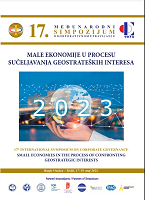RAČUNOVODSTVO ULAGANJA U DRUGE SUBJEKTE PO MODELU FER VRIJEDNOSTI KROZ OSTALI UKUPNI REZULTAT (FVOCI)
ACCOUNTING OF INVESTMENTS IN OTHER ENTITIES ACCORDING TO THE MODEL OF FAIR VALUE THROUGH OTHER COMPREHENSIVE INCOME (FVOCI)
Author(s): Vinko Belak
Subject(s): Business Economy / Management, Accounting - Business Administration
Published by: Finrar d.o.o Banja Luka
Keywords: Investments; Equity instruments; IFRS 9; FVOCI option; Fair value; Other comprehensive income;
Summary/Abstract: The model of fair value through other comprehensive income (FVOCI) is one of the three classification models of financial assets in IFRS 9 - Financial instruments, which is determined at the beginning based on the business model that will be applied when using it. Its basic characteristic is that changes in fair value are recognized in capital reserves and not in the profit and loss account. This avoids possible sudden impacts on profit or loss in the profit and loss account due to changes in the fair value of financial assets that have not been realized. When a financial asset is derecognised, accumulated reserves of gains and losses in other comprehensive income are transferred to retained earnings, and the difference between the fair value of the sold financial asset on the date of derecognition and the sale price is recognized in the profit and loss account. All of this is completely inadequately explained in point 5.7.10 of the IFRS 9, leading accountants and auditors to completely wrong conclusions. In order to properly apply the FVOCI model, this article proposes a solution in the following three steps: 1. In the first step, on the date of derecognition, the fair value of the financial asset that should be recognized through other comprehensive income should be determined again. 2. In the second step, based on the posting of the sales price, the investment account and their value adjustments are closed, and the difference between the sales price and the newly determined fair value should be recognized in profit and loss. 3. In the third step, the finally determined revaluation reserves created according to the FVOCI model should be transferred to the retained profit or loss within the capital. As a final conclusion, it can be pointed out that IFRS 9 in defining the accounting of investments in other entities according to the fair value through other comprehensive income (FVOCI) model is extremely incomprehensible and confusing to users. Even more, it leads them to completely wrong conclusions regarding the postings. This especially refers to item 5.7.10 of IFRS 9, so it is suggested that it be rewritten
- Page Range: 265-276
- Page Count: 12
- Publication Year: 2023
- Language: Bosnian
- Content File-PDF

